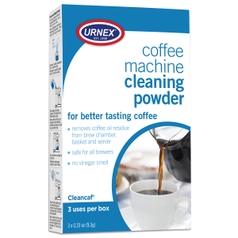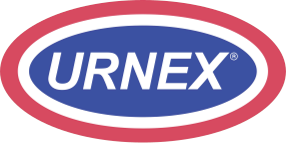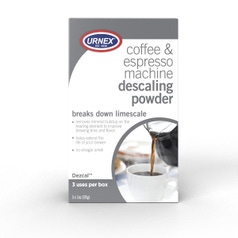
But for all that our coffee makers give us every day, we’re not always so good at giving our machines the attention they need. Even the most devout coffee fanatics might go weeks, months, or even years without properly taking care of their coffee machines. But understanding the difference between two essential methods to maintaining your coffee machine, cleaning and descaling, is the first step to enjoying the best tasting coffee possible and keeping your drip coffee maker, Keurig coffee maker or Nespresso machine running at peak performance for years to come.
A common misconception amongst coffee enthusiasts is that cleaning a coffee maker and descaling a coffee maker are the same thing. But cleaning and descaling are two different processes that address two different problems when brewing coffee. To enjoy coffee that is both delicious and hot, it’s important to understand the difference between cleaning a coffee maker and descaling a coffee maker, and how to do both.
What does it mean to descale a coffee maker?
A cup of coffee is nearly 99% water, making it one of the most important elements in brewing a good cup of coffee. All water contains minerals, like calcium and magnesium, which pass through your coffee machine and eventually accumulate on the machine’s heating element as limescale. Descaling a coffee maker is the process of removing that mineral buildup. Water that is considered “hard” is even more damaging to coffee machines because it carries a higher percentage of these minerals. Because the heating elements in a machine can’t be seen, months of mineral buildup could exist without you knowing it.
What happens if you don't descale your coffee maker?
Mineral scale buildup can have a negative impact on your machine’s boiler, which affects your coffee in a few ways:
- If the water can't reach its optimal brewing temperature, it is impossible to extract the full flavor from your coffee beans.
- Mineral scale buildup can clog water flow, and if not removed, can cause a machine to stop working.
- Your coffee won't be hot enough to enjoy.
So if it’s been a while since you’ve descaled your coffee maker, or you’ve never descaled your machine, you’re probably drinking coffee that is less flavorful and more tepid. And that’s if your machine hasn’t malfunctioned. Neither outlook is particularly good for you or your coffee.
How to Descale a Coffee Maker
We manufacture descalers for single serve coffee makers, drip coffee makers and espresso machines. These descalers are engineered to remove the toughest scale buildup from hot water tanks and coffee machine components without damaging the equipment, and allow machines to perform at optimal levels. By simply mixing the product with water, adding it to the machine’s water reservoir, and rinsing, your machine will be free of scale and brew a delicious, hot cup of coffee.

Coffee is by nature a very oil substance. Over time, coffee oils accumulate inside of your machine to form a rancid residue. Even with the best coffee beans or most advanced coffee machine, it’s an impossible feat to brew a good cup of coffee with a dirty machine. Cleaning your coffee equipment removes that built-up residue, and makes sure that your coffee will always taste fresh.
There are several coffee machine components that come into contact with coffee grinds or beans, and that are exposed to coffee oils, that need to be cleaned regularly. Those parts include carafes, brew chambers, portafilter baskets and grinder burrs.
What happens if you don’t clean your coffee maker?
If your machine is left alone without cleaning, that residue will have a few undesirable effects on your coffee:
- Your coffee will begin to taste bitter.
- Your coffee and coffee machine will produce an acrid smell.
- Coffee residue can cause clogging and blockages that can render a machine unusable.
Again, not an ideal situation for your daily brew. We wouldn’t wish poor-tasting coffee made by a smelly machine on any coffee drinker.
How to Clean a Coffee Maker
We manufacture cleaning products for use in capsule systems, coffee brewers and espresso machines. These products address the various cleaning needs for household coffee equipment and are available in powder, tablet, liquid and capsule forms. Each of our products is tested on a broad range of coffee equipment, are designed to rinse out of a coffee maker quickly and safely, and are odorless and non-toxic.
Descaling and Cleaning a Keurig Coffee Maker
We make a Single Cup Brewer Descaling and Cleaning Kit specifically designed for Keurig coffee makers. Each kit contains one cleaning cup and one bottle of descaling liquid. The cleaning cup cleans the brew chamber and exit needle to eliminate the coffee oil residue to make better tasting coffee. And the descaling liquid effectively breaks down the mineral scale on the heating element to extend the life of the machine.
Cleaning and descaling a coffee maker have their similarities. Both affect the unseen inner workings of a coffee maker, help them operate at their best, and both rid the machine of an unwanted substance. But it’s necessary to clean your coffee maker and descale your coffee maker to ensure your machine is brewing better tasting coffee for as long as possible.


Your coffee machine is something of a modern miracle. With just a few scoops of coffee grounds, some water and the push of a button, you’re reveling in a cup (or four) of fresh, hot coffee in minutes. Without this indispensable kitchen staple, we’d all be living in a gloomier, more sluggish world.
But for all that our coffee makers give us every day, we’re not always so good at giving our machines the attention they need. Even the most devout coffee fanatics might go weeks, months, or even years without properly taking care of their coffee machines. But understanding the difference between two essential methods to maintaining your coffee machine, cleaning and descaling, is the first step to enjoying the best tasting coffee possible and keeping your drip coffee maker, Keurig coffee maker or Nespresso machine running at peak performance for years to come.
A common misconception amongst coffee enthusiasts is that cleaning a coffee maker and descaling a coffee maker are the same thing. But cleaning and descaling are two different processes that address two different problems when brewing coffee. To enjoy coffee that is both delicious and hot, it’s important to understand the difference between cleaning a coffee maker and descaling a coffee maker, and how to do both.
What does it mean to descale a coffee maker?
A cup of coffee is nearly 99% water, making it one of the most important elements in brewing a good cup of coffee. All water contains minerals, like calcium and magnesium, which pass through your coffee machine and eventually accumulate on the machine’s heating element as limescale. Descaling a coffee maker is the process of removing that mineral buildup. Water that is considered “hard” is even more damaging to coffee machines because it carries a higher percentage of these minerals. Because the heating elements in a machine can’t be seen, months of mineral buildup could exist without you knowing it.
What happens if you don't descale your coffee maker?
Mineral scale buildup can have a negative impact on your machine’s boiler, which affects your coffee in a few ways:
- If the water can't reach its optimal brewing temperature, it is impossible to extract the full flavor from your coffee beans.
- Mineral scale buildup can clog water flow, and if not removed, can cause a machine to stop working.
- Your coffee won't be hot enough to enjoy.
So if it’s been a while since you’ve descaled your coffee maker, or you’ve never descaled your machine, you’re probably drinking coffee that is less flavorful and more tepid. And that’s if your machine hasn’t malfunctioned. Neither outlook is particularly good for you or your coffee.
How to Descale a Coffee Maker
We manufacture descalers for single serve coffee makers, drip coffee makers and espresso machines. These descalers are engineered to remove the toughest scale buildup from hot water tanks and coffee machine components without damaging the equipment, and allow machines to perform at optimal levels. By simply mixing the product with water, adding it to the machine’s water reservoir, and rinsing, your machine will be free of scale and brew a delicious, hot cup of coffee.


What does it mean to clean a coffee maker?
Coffee is by nature a very oil substance. Over time, coffee oils accumulate inside of your machine to form a rancid residue. Even with the best coffee beans or most advanced coffee machine, it’s an impossible feat to brew a good cup of coffee with a dirty machine. Cleaning your coffee equipment removes that built-up residue, and makes sure that your coffee will always taste fresh.
There are several coffee machine components that come into contact with coffee grinds or beans, and that are exposed to coffee oils, that need to be cleaned regularly. Those parts include carafes, brew chambers, portafilter baskets and grinder burrs.
What happens if you don’t clean your coffee maker?
If your machine is left alone without cleaning, that residue will have a few undesirable effects on your coffee:
- Your coffee will begin to taste bitter.
- Your coffee and coffee machine will produce an acrid smell.
- Coffee residue can cause clogging and blockages that can render a machine unusable.
Again, not an ideal situation for your daily brew. We wouldn’t wish poor-tasting coffee made by a smelly machine on any coffee drinker.
How to Clean a Coffee Maker
We manufacture cleaning products for use in capsule systems, coffee brewers and espresso machines. These products address the various cleaning needs for household coffee equipment and are available in powder, tablet, liquid and capsule forms. Each of our products is tested on a broad range of coffee equipment and are designed to rinse a coffee maker quickly and safely.
Descaling and Cleaning a Keurig Coffee Maker
There might not be an easier or quicker way to brew a cup of coffee than to pop a K-Cup pod into a single-serve Keurig coffee maker. But Keurig machines need to be cleaned and descaled like any other coffee maker to ensure the coffee’s flavor isn’t diminished from the oily residue and that the machine is operating without technical issues.
We make a Single Cup Brewer Descaling and Cleaning Kit specifically designed for Keurig coffee makers. Each kit contains one cleaning cup and one bottle of descaling liquid. The cleaning cup cleans the brew chamber and exit needle to eliminate the coffee oil residue to make better tasting coffee. And the descaling liquid effectively breaks down the mineral scale on the heating element to extend the life of the machine.
Cleaning and descaling a coffee maker have their similarities. Both affect the unseen inner workings of a coffee maker, help them operate at their best, and both rid the machine of an unwanted substance. But it’s necessary to clean your coffee maker and descale your coffee maker to ensure your machine is brewing better tasting coffee for as long as possible.



